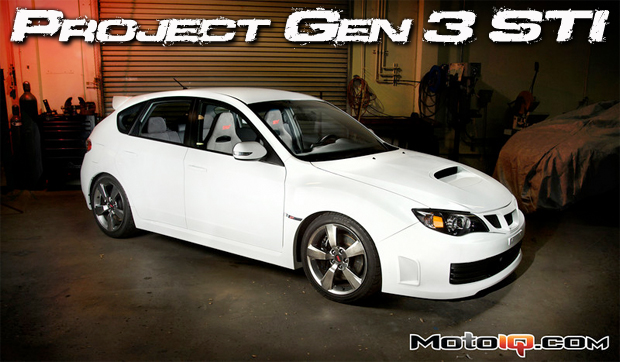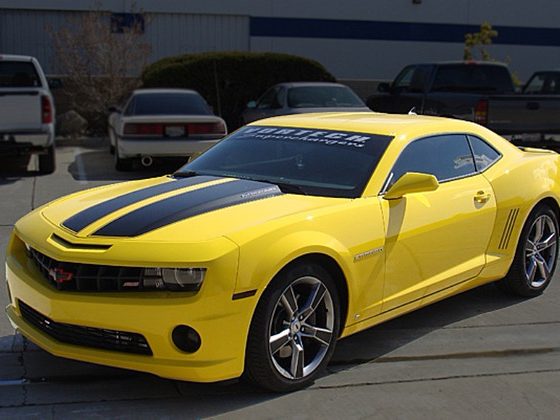
Project STI- Generation 3, an Introduction
By Mike Kojima, photos by Jeff Naeyaert
Introduced in 2008, the latest Subaru STI is the third generation of its model type. Designated GR, the new STI is an all new platform. The new GR chassis has a 3.3 inch longer wheelbase but a 2.8 inch shorter overall length for less overhangs and a lower polar moment of inertia. The new chassis is 2.2 inches wider and 2.2 inches higher and has gained about 70 lbs for a curb weight of around 3,375 lbs.
Subaru states that the new chassis is stiffer in bending and torsion but we were hard pressed to find data on exactly how much. Considering that the GD was known to be an exceptionally stout chassis, that data would be interesting to review. The big difference between the new GR chassis and the second generation GD chassis is the suspension.
 |
| Look how much more simple the GD's rear suspension is. OK, its not an STI but this is what we could come up with. |
 |
Here you can see the GR's rear suspension from the side. The trailing arms job is mainly to absorb braking and engine torque loads. Its bushings are designed to resist fore and aft motion and allow side to side movement so the short toe link can toe the suspension in. You can see the upper links position here as well. Note the bosses for a disk brake caliper in this drum brake equipped car. |
Rear Suspension
The GR’s suspension is a multilink vs the old McPherson struts. Due to their potential ability to keep the tire's tread flatter on the ground for more grip under roll when cornering, multilinks are usually coveted as performance increasers over more mundane and common sedan suspension systems like the economical and pedestrian McPherson strut. Frankly, we are puzzled why Subaru has opted for a multilink in the back of the STI. Usually nose-heavy, understeer prone AWD cars are hurting for front grip. Putting a multilink in the back seems a little counterproductive for performance as it would tend to increase dork-safe but racer-annoying understeer. A multilink also has more parts and is inherently much more complex and expensive to produce than a McPherson Strut system, hence Honda doing away with it on the front of the new Civic. Engineering additional cost into a mid-priced sedan is a very unusual move in this day of brutal competition and shrinking margins in this competitive market.

Our take is that the main reason why Subaru has opted for the multilink is to offer a car with a flatter trunk or rear hatch area for more utility. With no intrusion of the McPherson Struts shock towers, the trunk or in the case of the soon to be released WRX, rear hatch area can be one vast plain of flatness, better to store your luggage, golf clubs or bodies in. Doing away with shock towers also means that rear seat room can be improved and there are perhaps some safety reasons as it is possible to design more crush from side and rear impacts with the multilink. Perhaps the reason can be as simple as Subaru is trying to emulate its arch rival, the Mitsubishi EVO which also has Mac struts in the front and a multilink in the rear.
Multilinks are cool but if Subaru was only intending to use it on one end of the car, we would prefer it in the front instead, ala the old Infiniti G20 or Audi A4. We would take less understeer and more front grip over a flat trunk floor any day.
 |
| The present Impreza’s rear suspension is a good ole McPherson strut. The toe link is nearly the same length as the lower link which means that toe in under roll is minimal. As you can see, this is a very simple and straightforward rear suspension. |
 |
Yes, it is a real multilink. A lower link, a trailing link and a toe link all in a pretty close to the same plane line act like a virtual lower control arm. The shorter upper link swings in a tighter arc than the lower link, assuring a gain in negative camber under roll. The short toe link gives passive toe in under roll. |
The Impreza’s multilink has its geometry arranged so that the suspension will gain negative camber under roll at a greater rate than the old cars McPherson struts. This keeps the tires tread flatter on the ground rather than allowing it to tilt up onto its outside edge. With its footprint maintained, the tires grip is improved under cornering over the old struts. Some multilinks like the one found in the back of the Scion TC do not have much negative camber gain but this suspension has a good amount. With shorter front lower links the suspension will also passively toe in the rear wheels under roll. Both of these measures will tend to increase understeer and provide stability when cornering.
 |
| A simple and straightforward trapezoidal parallel link with trailing arm with a McPherson strut, the exact same stuff you will find in the rear of an old Nissan Sentra! Its probably fine for the rear of a front heavy AWD car. |
 |
| We wish Subaru had put a cool multilink with a fast camber curve up front where the car needs all the front grip it could get ala Audi or the Infiniti G20 but the wide boxer engine would probably make this a nightmare. |
The GR’s Multilink rear suspension has more antisquat geometry than the GD’s. This will reduce the amount of annoying engine torque induced squat under acceleration. Anyone who has driven a healthy modded GD STI with street suspension knows what I am talking about. This also means that the suspension will become more bound up under torque load increasing the suspensions resistance to movement under load. More antisquat can mean that the car can have a greater tendency to oversteer on the throttle because the bind will act like an increase in suspension stiffness when the throttle is applied. Perhaps this may cancel out some of the understeer inducing effects of greater negative camber gain and passive toe in later in a turn.
Another observation is that Subaru used small rubber bushings at the pivot points. This is good because it reduces overall compliance and will help keep the tires pointed where the Subaru engineers intended under load. We have been rather dismayed at the huge squishy rubber bon bons that many late model suspension systems are seemingly sprouting lately in an attempt to reduce noise and harshness.




